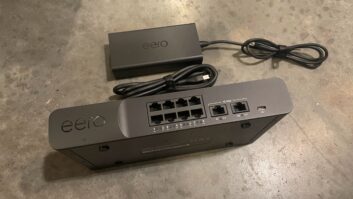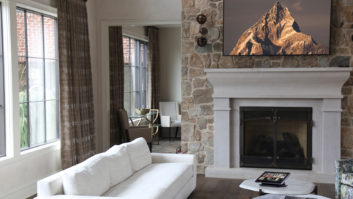
Navigating the choices for wireless mesh networks, or mesh Wi-Fi as it is commonly called, can be confusing and difficult. The key to deploying this twist on traditional Wi-Fi is to step back and review the fundamentals of wireless local area networks (LANs) first.
Wired Ethernet is still the ideal solution for residential, business, and commercial networking. Signals travel faster, further, and with the least interference when using copper or fiber optic cables. The rule-of-thumb to hardwire everything that is nailed down or doesn’t move is golden. Strive to use wireless only for mobile devices such as smartphones, tablets, and laptops or devices that do not have a wired interface.
Wires that work when properly installed are virtually maintenance-free and don’t require adjustments, upgrades, or periodic technology refresh/upgrades to keep working as originally spec’d.
Wireless networking signals are radio signals that travel through space impeded by physical materials and bouncing off surfaces and walls. No matter how meticulous the initial design and engineering of a wireless network, external factors can degrade performance or cause unexpected and hard-to-diagnose problems.
Both DIY and professional installers often overlook the subtle, but crucial issue of external interference. No matter how much you have honed your skills for heat-map analysis, spatial antenna visualizations, or experience in choosing wireless access point placement and orientation, that pesky neighbor suddenly installing the newest Wi-Fi gear can wreak havoc with a finely tuned wireless installation.
Apartments, temporary residences, vacation rentals, and timeshares are a few of the logistical challenges where installing wired networking is usually not an option. Installing wires can be challenging when walls and building materials such as concrete, stone, or other barriers are present, but not insurmountable.
When prospective clients seek my assistance in choosing the latest Wi-Fi gear to solve their networking problems, I challenge them to consider installing new wiring first. If there is any possibility of hardwiring, I will bring in the appropriate skilled installers or contractors for a permanent solution instead of a temporary fix using only wireless gear.
I’m a strong believer in spending more of the budget on wiring rather than equipment. Clients willingly spend thousands of dollars on devices (gear and gadgets) that will be obsolete in a few years but are psychologically reluctant to spend ‘real money’ on the labor and materials to pull more Ethernet wire.
Using a zero-budget approach, I skew the proposals towards hardwiring and infrastructure with very cost-effective equipment instead of the best networking gear.
It’s a win/win — many clients decide to do both, while those that opt for the frugal approach have less resistance replacing the network gear in the future, which can use the additional Ethernet wiring that was previously installed.
Related: Building a Robust Network
Traditional Wireless Solutions
For mobile and wireless devices, Wi-Fi solutions using one or more wireless access points (WAPs) are a proven and well-understood solution. For larger homes with multiple floors, irregularly shaped areas, back or front yards, or covering dead-zones that otherwise can’t be reached, multiple WAPs have proven their worth.
Each WAP is connected back to the central equipment area using wired Ethernet cables. This provides a star topology that optimizes bandwidth and reliability as each WAP is self-contained. The failure or one unit doesn’t affect any of the others.
The wired connection, sometimes called an uplink or backhaul, provides maximum bandwidth between each WAP and the network switches, router, and broadband Internet connection. The wired backhaul, when used with power-over-Ethernet (PoE) switches or power injectors to send low-voltage power down the same cable used for the data connection, allows installing WAPs without needing AC power outlets. WAPs can be conveniently installed on ceilings and walls and hidden in closets or other less visible areas.
When Wi-Fi Doesn’t Reach
When the wired and wireless network doesn’t reach everywhere needed, and additional wiring for wired WAPs cannot be installed, another solution is needed. Commonly used options, some of which are still in use, have been to re-use existing wiring of other kinds. Multimedia over Coax (MoCA) has successfully used existing coaxial cable with special conversion hardware to transmit Ethernet and various other proprietary devices have entered and exited the market at various times.
I have seen products from a few vendors that claim to send Ethernet over two-wire doorbell wire to install entry station and video doorbells, but these are specialized, proprietary solutions the must be used with great care.
Wi-Fi signal repeaters, often called Wi-Fi extenders, have provided a more general solution. These devices connect to the existing Wi-Fi network as a client device and then create their own Wi-Fi network, effectively extending the range of the wireless signal. Wi-Fi extenders are often used as one-off fixes to patch over a dead-spot or push the range just a little further to reach the front door for a smart lock or video doorbell to have connectivity.
Wi-Fi extenders have a reputation for being unreliable, difficult to install, and sometimes proprietary to a specific manufacturer’s Wi-Fi gear. Most also reduce the effective speed in half, as they have a single internal radio that is shared between connecting back to the main Wi-Fi system and the additional user devices.
Because they create a new Wi-Fi network with a different network identifier (SSID), it is not possible move around the home and seamlessly maintain a Wi-Fi connection. As you move out of the range of the primary Wi-Fi network, you have to manually adjust your smartphone or laptop to connect to the alternate Wi-Fi network.
How Mesh Wi-Fi Works
Mesh Wi-Fi networks were invented to solve all the above problems and more — including the inability of wired Ethernet to reach everywhere in the home, deficiencies of wired backhaul WAPs, unreliable Wi-Fi extenders, limited roaming, difficult installation, and minimal management.
Mesh Wi-Fi devices have at least two completely independent radios. This allows one radio to establish a wireless link back to the main network while the second radio is devoted to only servicing client connections. The first generation of mesh Wi-Fi devices went further and included triple radios. The radios communicate on a mix of the older 2.4 GHz Wi-Fi frequencies (longer range) and the newer 5 GHz Wi-Fi frequencies (higher speeds).
Unlike wired and switched Ethernet, Wi-Fi is a one-at-a-time shared medium (each device has to wait its turn to transmit), so multiple radios result in much higher throughput. Much like a three or four-lane freeway can carry more cars than a single lane country road. The Wi-Fi standard has evolved to support MU-MIMO (multi-user, multiple input, multiple output) transmission, which effectively allows simultaneous traffic on each of those lanes, but only the newest client devices have MU-MIMO hardware support, so multiple radios is a much bigger “bang for the buck” to increase throughput and bandwidth.
The second big improvement with mesh Wi-Fi is the ability for each mesh unit to relay the wireless traffic from a neighboring unit. This allows any-to-any wireless connectivity among all the WAPs.
Of course, there is no free lunch. When data from a client device must pass through several wireless mesh WAPs before reaching the wired switch and router, there will be a decrease in speed and throughput.
In a true wireless mesh configuration, the incorporation of three radios can be key. One radio can be devoted to the wireless backhaul link to the main network, a second radio can service client devices, and a third radio can handle the wireless backhaul from another mesh WAP.
Mesh Wi-Fi devices have built-in intelligence to automatically allocate the radios efficiently and manage the connections between all the units. Firmware in each unit measures real-time speed and interference and balances the trade-off between high speed and stronger signals.
However, the real breakthrough in mesh Wi-Fi WAPs has been the ability to support all these different topologies, configurations, and bandwidth needs without any configuration by the installer or end-user.
In some mesh Wi-Fi devices the radios are allocated as needed and not permanently assigned to only one function. The details are often proprietary, so the only way to understand how the devices work is to use them in actual installations and evaluate their performance.
The technology keeps evolving — some equipment dynamically assigns all radios so there really isn’t a backhaul radio, client radio, or mesh radio — every radio can be used however the firmware deems best at any moment in time.
Related: Review – Luxul MN-10 Epic Mesh Wireless Network System
Connecting Mesh Wi-Fi to the Wired Network
A wireless network isn’t useful by itself, and must connect into the wired network or gateway to provide access to the Internet and other systems. A mesh Wi-Fi device will have at least one wired Ethernet port for this purpose. Hopefully it will be capable of full gigabit Ethernet speeds for maximum throughput.
The quantity, configuration, and physical form factor of these ports varies greatly. Some manufacturers include one Ethernet port in every mesh unit, some include two, and a few have more for easier connection of additional wired devices.
Typical deployment might be to place a mesh WAP in a media room or bedroom so the additional ports allow hardwiring smart TVs, streaming boxes, gaming consoles, DVRs, or AV receivers, which are often physically clustered together.
In the consumer space, it is common to see multiple configurations from a manufacturer to help them lower cost and address different customer needs. Some mesh Wi-Fi devices have no wired Ethernet ports and are designed to be used only to extend the reach of the wireless network. They cannot attach additional local devices or connect back to the main network with a wired link.
Often these units have built-in AC power and a form factor that looks more like a large nightlight, so they plug directly into a wall outlet and hug the wall for a zero-footprint install. Don’t overlook these units — they are often ideal for bedrooms, hallways, and other areas where ceiling or wall mounting would be ugly and there isn’t a bookcase or cabinet to hide a tabletop or freestanding device and power cord.
Somewhat a step backward, most of the first-generation mesh Wi-Fi manufacturers have introduced new models with only two radios instead of three. They are focused on lowering the cost even with the accompanying lower performance and less flexibility as the industry has entered a period of consolidation and fierce competition.
It’s the classic marketing pitch of making products that are faster, better, and cheaper — but you can only pick two out of three!
Mesh Wi-Fi systems are not interoperable. All the wireless WAPs, or “mesh points,” must be from the same manufacturer. Although Wi-Fi transmission is standardized by the IEEE, the communication between mesh points to establish wireless backhaul, load-balancing, and client connections is vendor specific.
This may change going forward, but, when deploying a mesh Wi-Fi system, all units and any future expansion units must be purchased from the same manufacturer.
Related: Mesh Networking Is Here to Stay
Modular or Integrated?
When dealers, integrators, manufacturers, and consumers discuss networking equipment choices and capability, there is a lot of blurring of boundaries between features and functions. Most of us understand the difference between wired and wireless networks, local networks versus wide area networks, and private nets versus the Internet, but we shouldn’t assume everyone else does.
The box most consumers have installed from their cable or broadband ISP is a multifunctional marvel. It contains a broadband modem, a single Wi-Fi access point, a 4-port Ethernet switch, a router, a firewall, and a remote management interface. (And more! It might also include digital phone service, alarm or security system interfaces, and cloud or local DVR TV recording.)
There are many different ways to replace or supplement this all-in-one approach with a modular set of equipment to provide more capability, better throughput, increased resiliency and reliability, and other benefits.
Very commonly, we try to use only the required broadband modem from the ISP and replace all the other networking functions. At a minimum, the major modules are separate devices for Wi-Fi, routing/firewall, and Ethernet switches.
Just as home entertainment systems have evolved from home-theater-in-a-box to separate components — each carefully selected to achieve the desired capability and mix of price/performance — networking gear can be approached the same way.
The subtle point here is that many mesh Wi-Fi systems assume they are in full control. They consist of WAPs, but also want to be the primary router, firewall, network switch, and management interface for the entire network. Some mesh Wi-Fi systems have the ability to be used only as Wi-Fi WAPs so they will peacefully co-exist with the network gear that already exists or that you prefer to use.
In my opinion, the ability to configure a mesh Wi-Fi device into bridge mode, allowing it to be used with any existing modular or integrated network design, is a crucial requirement for maximum flexibility.
Early consumer mesh Wi-Fi systems that only worked in router mode had their lunch handed to them and they grudgingly modified their products to provide the necessary bridge mode configuration options. I recommend only using mesh Wi-Fi devices that have a bridge mode option. There is no requirement to use it — you can still use the router, switches, firewall, and management all from the same company, but having the option to work with existing equipment is an important tool.
For the perfect network for our ideal client, we want to engineer the entire network, but a fair number of clients may have a working network that is fine; they only need to increase the reach and throughput of their Wi-Fi. Being able to incrementally add mesh Wi-Fi to solve those problems without a wholesale replacement of the entire network system might be the difference to land the job.
About the Author

Robert Spivack is an industry veteran with over 30 years of experience. Armed with an Engineering degree from Cornell University, Spivack started his career as a minicomputer operating systems software developer for Hewlett Packard. He went on to work as a marketing technology analyst for Eagle Computer and as a product manager for Wyse Technology, two early leaders in IBM PC clones.
Spivack worked with several startups, serving as director of marketing for Castelle, a network appliance pioneer in personal computer local area networks. He joined Cisco Systems as a product marketing manager responsible for the highly successful Cisco 2500 branch office routers.
Venturing on his own, Spivack provided technology and marketing consulting services to corporate clients throughout the SF Bay Area before starting his own web hosting company.
He is the founder of DoItForMe.Solutions, a smart home integrator providing design, installation, consulting, and support services bridging the gap between do it yourself (DIY) products, do it for me (DIFM) services, and fully custom traditional automation systems.
DoItForMe.Solutions is a CEDIA member, Lutron Residential Pro Gold Dealer, and an authorized dealer for a select group of DIY, DIFM, and CI product lines.







